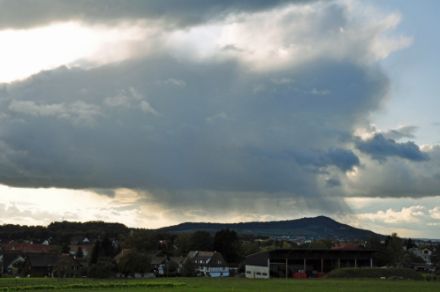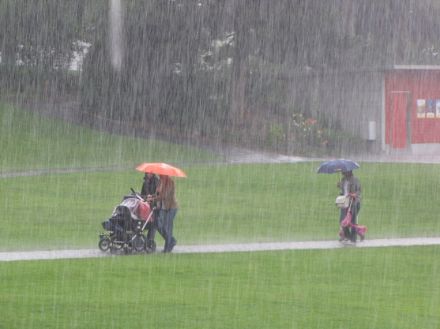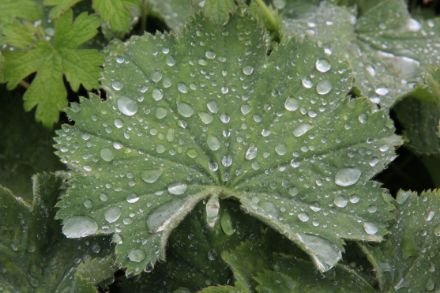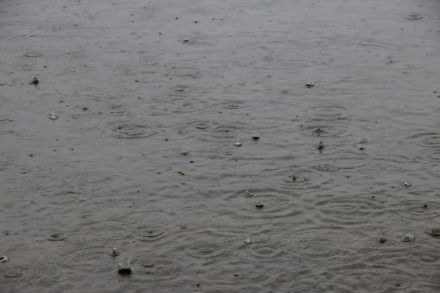Service Navigation
Search
The British Met Office has compiled various facts about rain, which we expand on here with information from MeteoSwiss.
1. Phantom rain - Streaks of rain
Under certain conditions, raindrops can fall from the sky without ever reaching the ground. These streaks of rain are known as Virga, whereby precipitation falls from a cloud and evaporates or sublimes while it is still in the air, transforming from a solid directly into its gaseous form.

When precipitation falls through layers of air with winds blowing with varying force or in different directions, the streaks of rain appear bent. Virga can be associated with the following types of cloud: Cirrocumulus, Altocumulus, Altostratus, Nimbostratus, Stratocumulus, Cumulus and Cumulonimbus.
2. Is it better to run or stroll?
When it rains, people often wonder what the best way is to stay dry. Is it better to run to one’s destination and be exposed to the rain for a shorter time, or is it better to walk at a leisurely pace and be hit by fewer raindrops?
There is no definitive answer to the question, as there are numerous factors affecting whether and to what extent a person gets wet in the rain. These include the direction of the wind, the size of the raindrops, and the height and breadth of the person in the rain.
Italian physicist Franco Bocci, who has researched this question, explains further in SPIEGEL ONLINE: “There is no definitive answer.” Based on complex mathematical experiments, he does however come to the conclusion that it is generally better to run as fast as possible – although not always.

3. Rain has a scent
When raindrops fall onto dusty, dry soils, they trap tiny air bubbles which shoot upwards, like in a glass of Champagne. These air bubbles then burst out of the raindrop, and the scent is distributed by the wind. This is what gives rise to the familiar scent of rain. The scent is also known as “Petrichor”.

4. The shape of raindrops
Raindrops are often depicted in the shape of a teardrop, which (unfortunately) is incorrect. In the atmosphere, raindrops form a spherical shape: Water molecules bind and are held together by surface tension. As soon as the raindrops begin to fall, their shape changes constantly. They hit other raindrops, and the air resistance flattens out their underside, causing them to take the shape of a jelly bean.

5. How long does a raindrop take to fall to the ground?
There is no simple answer to the question of how long a raindrop takes to fall. It depends on the height from which the drop is falling, as well as how large it is. Travelling at an average speed of around 22.5 km/h, a raindrop would take two minutes to reach the ground from a cloud height of around 760 m. Larger raindrops would fall at a speed of around 32 km/h and take one and a half minutes, whereas small ones would take up to seven minutes for the same distance.

6. Where is the wettest place in the world?
The location with the most precipitation in the world is Mawsynram in the State of Maghalaya, India, where an average of 11,971 mm of rain falls per year. Mawsynram is situated near the Bay of Bengal, in the Garo Hills to the south of the Himalayas. The southwesterly monsoons bring warm, moist air masses to the mountains, where they accumulate. This leads to huge amounts of rainfall.
The wettest location in Switzerland is on the Säntis (2,502 m.a.s.l.), with a mean annual precipitation amount of 2,840 mm (1991–2020).

7. Most rainfall in a day in Switzerland
The most rainfall measured in one day in Switzerland was 455 mm, recorded on 26th August 1935 in Camedo (550 m.a.s.l.), Ticino. The largest amount of snow falling in one day was 130 cm, recorded on the Bernina Pass (2,307 m.a.s.l. ) on 15th April 1999.